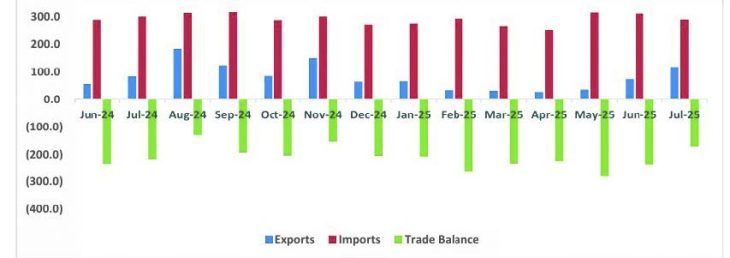
Malawi’s Trade Deficit Narrows: A Silver Lining for Economic Growth
Key Business Points
- Malawi’s trade deficit has decreased to $173 million, driven by a 59.1% surge in exports, primarily due to tobacco sales, which is a positive sign for the country’s export sector.
- The improvement in trade deficit is also attributed to softer import demand, with imports falling by 6.9% to $290.1 million, mainly due to reduced spending on fuel, vehicles, and cereals.
- To sustain this growth, export diversification is crucial, as tobacco continues to dominate Malawi’s export basket, and the country needs to explore other export opportunities, such as legumes, manufactured goods, and services.
Malawi’s trade deficit has shown a significant improvement in the third quarter of 2025, posting a $173 million deficit, the lowest in many months. This is largely attributed to a surge in tobacco exports, which rose sharply to $86.6 million from $52.3 million in June. The improvement in trade deficit is also due to softer import demand, with imports falling by 6.9% to $290.1 million. Reduced spending on fuel, vehicles, and cereals contributed to this decline. According to Scotland-based Malawian economist Velli Nyirongo, this improvement is temporary relief and warns against complacency, as tobacco continues to dominate Malawi’s export basket.
The narrowing trade gap has supported the country’s foreign exchange position, with foreign exchange reserves rising to $607.7 million in July. This increase reflects higher earnings from tobacco and improved private sector reserves. However, Nyirongo emphasizes the need for structural change and diversification into legumes, manufactured goods, and services to sustain growth. Mzuzu University economist Christopher Mbukwa attributes the decline in imports to foreign exchange shortages, which may have subdued import demand.
The Ministry of Finance and Economic Affairs prioritizes fertilizer and fuel imports when allocating foreign exchange, often leaving less available for other imports. The monthly imports value for the country is pegged at $250 million. As the Malawi Government pushes for export diversification under the African Continental Free Trade Area (AfCFTA), it aims to target international trade fairs, such as the 2025 Intra-African Trade Fair. With a market of 1.2 billion people and a combined gross domestic product of $2.5 trillion, covering 55 African countries, AfCFTA presents a significant opportunity for Malawi’s export sector. As Secretary for Trade Christina Zakeyu notes, Malawi needs to zithandiza za export (improve exports) to bridge the trade deficit gap.
Available data show that Malawi annually exports goods valued at $1 billion against imports at $3 billion, creating a deficit of $2 billion. To address this, the country needs to kambirana za export (diversify exports) and explore new markets. With the AfCFTA in place, Malawi has a chance to pangana ndi masoko (access new markets) and increase its export earnings. By doing so, the country can reduce its dependence on tobacco and achieve kusintha kwa chilengedwe (economic growth) in the long run.
What are your thoughts on this business development? Share your insights and remember to follow us on Facebook and Twitter for the latest Malawi business news and opportunities. Visit us daily for comprehensive coverage of Malawi’s business landscape.
